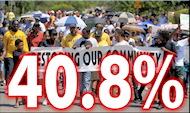Executive Summary of the NAACP 'Smart and Safe' Campaign
For 100 years, the National Association for the Advancement of Colored People (NAACP) has played a pivotal role in shaping a national agenda to ensure the political, educational, social, and economic equality of African Americans and other people who have faced historical discrimination in the United States. To support and leverage the work of our local units, who work tirelessly on behalf of many communities in crisis, the NAACP has developed a “smart and safe” framework in which to implement an advocacy agenda to ensure equal justice and safer communities. Our goal is to ensure public safety as a civil and human right. We believe this can be accomplished when we focus on what matters and what works.
When police officers focus on behavior rather than physical appearances, they catch more people who have broken the law.
Everyone wants to feel safe, and everyone wants to know that there are authoritative figures maintaining order. The use of race as a proxy for culpability leads to biased policing practices that challenge the integrity of law enforcement. Also, due to the trend of overpolicing of American schools, many normal adolescent behaviors, are today treated as criminal offenses. These practices contribute to a lack of trust between law enforcement and the communities of color that it protects and serves, which undermines fair practices and serves to deter a climate conducive to producing safe communities. It is because of this lack of trust that many African American communities do not believe the police will protect them if they come forward and cooperate in murder cases, thereby affecting case closure rates. It is because of this lack of trust that implicit biases are allowed to fester and grow without proper training to promote fair enforcement of the law, thereby affecting the way that law enforcement interacts with the communities it is entrusted to serve. It is because of this lack of trust that African Americans continue to be the most victimized community in the nation, thereby contributing to the disproportionately high rates of stress, abuse, addiction, Post Traumatic Stress Disorder, and other health indicators affecting the overall wellness of our communities. This lack of faith in the integrity of the system has deteriorated the social conditions that promote effective law enforcement and the partnerships that encourage public safety.
When our communities send first- or second-time, low-level, nonviolent drug offenders to prison, rather than offer rehabilitation or other common alternatives, we waste money, needlessly break up families, and steer many people into a life of crime.
In 2008, the United States spent more than $68 billion on incarceration. Largely as a result of the War on Drugs, the nation’s response to drug addiction has been punitive and narrow, tainted by a disparate racial impact on people of color. African Americans are arrested for drug offenses at 3.5 times the rate of their White counterparts, despite the fact that rates of drug use among each population are comparable. Data show that the War on Drugs and lack of judicial discretion to consider each case without mandatory minimum sentences have reduced the public’s faith in the integrity of our criminal and juvenile justice systems. A recent Zogby poll found that 76 percent of likely voters view the War on Drugs as failing —an assessment fueled by the fact that the odds of an African American drug offender being sentenced to imprisonment are approximately 20 percent higher than the odds of a White offender, and the fact that the “typical” African American drug offender receives a sentence approximately 10 percent longer than a comparable White drug offender.
In fact, the spending on incarceration has increased by 336% since 1986, a signal of our nation’s growing reliance on imprisonment to solve social problems—specifically addiction and mental illness, which could be more effectively treated outside, often before a person comes into contact with the criminal justice system. Over half of inmates in our nation’s prisons and jails have a mental illness; 61 percent of prison inmates who report mental illness have a history of committing violent offenses, and a quarter have been previously incarcerated three or more times. These numbers clearly indicate that drug offenders cannot be warehoused into wellness and our communities cannot be made safe by this warehousing. Though severe mental illness, drug addiction, and the violence and victimization that often accompany these concerns are serious matters that deserve intervention, research shows that imprisonment is an expensive and ineffective strategy for dealing with them. A number of states have already saved resources after developing alternative sentencing options for drug offenders and those who are mentally ill. However, many more states continue to individually spend hundreds of millions of dollars—and in some cases, billions of dollars—on corrections for people who would be better served through intensive community-based treatment and counseling.
If society sends people home from prison with more skills than when they entered, then more people get jobs, pay taxes, reunite with their families, and live as productive members of our communities, and fewer return to prison.
Incarceration has often been called “rehabilitation”; however, the warehousing of human beings is one of the least rehabilitative processes known to modern societies. The collateral costs—including increased financial burden upon social welfare systems to house children in foster care; increased rates of unrecoverable loss of wages, skills, and employability as a result of incarceration; and loss of tax revenue to states—are expensive checks to write in the name of being “tough on crime,” especially when evidence suggests that other interventions are more effective. Although prerelease programs exist in correctional facilities throughout the nation, they are often inadequate and lack proper coordination with community-based organizations that work with this population when they return to their home communities. However, when an investment is made to develop the minds and skills of those who have violated laws and are sentenced to spend time in secure confinement, then they can return to their communities with more options than when they left.
When we invest in helping people with a criminal record to access jobs, housing, education, civil society, and their children and families, more people are able to repay their debt to society, their victims, and themselves, and fewer commit additional crimes.
As more than 600,000 individuals leave U.S. prisons each year, our communities continue to grapple with the unique challenges presented by those who ostensibly have “paid their debt to society” and yet face barriers to reentry that effectively continue their punishment. Today, our nation’s returning citizens face significant and numerous barriers to finding housing and employment, regaining custody of their children, receiving a personal loan or financial aid toward school, and having other basic tools needed to rebuild their lives. Without an opportunity for redemption and the chance to move forward, up to half of all released individuals may return to prison, costing taxpayers more money and continuing to undermine our nation’s overall workforce productivity. Without any opportunity for employment or support, many pose a threat to public safety by committing new crimes—some petty, some not—and cycling back into prison. For this reason, many leading law enforcement agencies, including the National District Attorneys Association and national police organizations, have made facilitating successful reentry from prison and jail a priority approach to public safety. More resources are needed to ensure a successful reintegration of those who have a criminal record. Just as no single factor leads one down a path toward criminal behavior and incarceration, no single resource can provide successful reentry. It takes the collective effort of our society to provide opportunities for redemption.
Federal policymakers have an immediate opportunity to pass legislation that will begin to develop and implement a range of criminal justice policy reforms. These reforms include eliminating racial profiling; building trust, integrity, and accountability in law enforcement; and eliminating the mandatory minimum sentencing disparities that unfairly and adversely impact African American and Latino communities. At the state level, policymakers have the opportunity to embrace research-based and cost-effective approaches to sentencing and incarceration—those that allow our legal and criminal justice decision makers to objectively respond to incidents of violence and victimization and allow for fair and equitable responses to criminal or delinquent behavior. Through these policy opportunities and the development of effective sentencing alternatives to incarceration, we can stop the cycle of violence and victimization.
The demands of our current economy present new challenges and opportunities for our nation. Across the country, communities are grappling with the barriers presented by an underperforming economy and a strained fiscal climate. People of all socioeconomic strata continue to seek inclusion in processes that will improve their employment outcomes—and people living with a criminal record are no exception. Like most Americans, most of these returning citizens want the opportunity to be forgiven for their mistakes and to take ownership of their lives.
All communities seek a fair and just administration and enforcement of the law. Our goal is to ensure that a structure is in place to allow all communities—irrespective of race, gender, ethnicity, nationality, sexual orientation, age, or religion—to fully exercise their right to be safe. The NAACP will continue to work with key stakeholders, including law and policymakers, correctional institutions, scholars, the faith community, civic organizations, and others to report abuses of power in the criminal justice system, to develop thoughtful approaches to support public safety, and to shift our national priorities from incarceration to rehabilitation.











